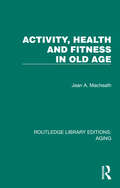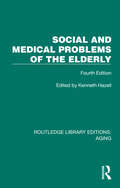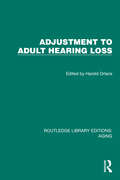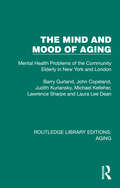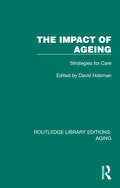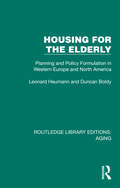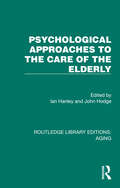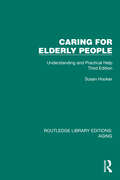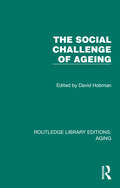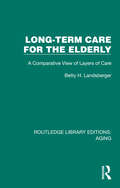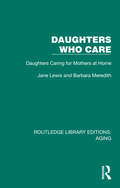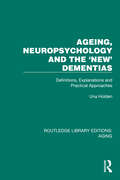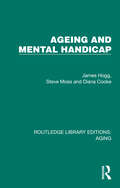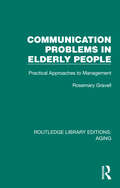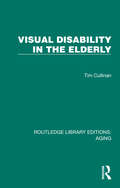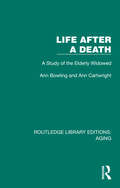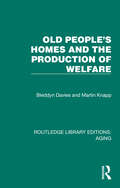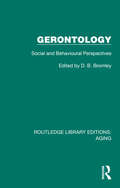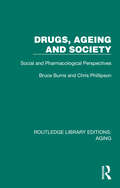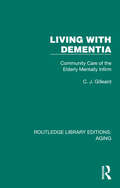- Table View
- List View
Activity, Health and Fitness in Old Age (Routledge Library Editions: Aging)
by Jean A. MacheathPhysical activity is a key element in maintaining the independence and quality of life of older people. It is vitally important that those in the caring professions working with the elderly are aware of the capabilities and expectations of older people in this respect.
Social and Medical Problems of the Elderly: Fourth Edition (Routledge Library Editions: Aging)
by Kenneth HazellIn the 1960s and 1970s doctors were increasingly trained to apply science to the eradication of disease, the accent being on the treatment of disease rather than the true welfare of the patient. This is not the same as dealing with illness and its attendant problems.
Adjustment to Adult Hearing Loss (Routledge Library Editions: Aging)
by Harold OrlansOriginally published in 1985, the chapters in this book were, with two exceptions, first prepared for and discussed at a monthly research seminar series on Hearing Loss in Adulthood during the 1983-1984 academic year. One of the exceptions was included to fill a major gap in the literature dealing with the experience of persons who suffer a moderate hearing loss in midlife. The other, by the editor, presents his observations and reiterates significant points made by a number of seminar members. As a whole this book shines a light on the experience of hearing-impaired people, particularly the loss of hearing in later life.
The Mind and Mood of Aging: Mental Health Problems of the Community Elderly in New York and London (Routledge Library Editions: Aging)
by Barry Gurland John Copeland Judith Kuriansky Michael Kelleher Lawrence Sharpe Laura Lee DeanOriginally published in 1983, this cross-national study had three aims. First, to examine the cross-national differences among the elderly community in the prevalence of psychiatric problems and their relationship to other health and social problems. Second, to examine the differences in health care of aged people, with a view to providing a framework for improvement of health and support services to those elderly with psychiatric problems who reside in the community. Finally, the differences in the course and outcome of psychiatric disability with implications for the role of healthcare and community resources in reducing chronic disability or its consequences.
The Impact of Ageing: Strategies for Care (Routledge Library Editions: Aging)
by David HobmanAt the beginning of the 1980s, the previous few decades had been characterised by a ‘population explosion’ amongst the older age groups. Due to the success of medical science at prolonging life, this phenomenon had been experienced throughout both the developing and the developed world. Given the acute economic difficulties faced by the countries concerned, it was apparent that the allocation of resources, in terms of cash and care, would have to concentrate on the oldest and frailest members of the community.
Housing for the Elderly: Planning and Policy Formulation in Western Europe and North America (Routledge Library Editions: Aging)
by Leonard Heumann Duncan BoldyDuring the 1970s housing and social welfare policy as it affected the elderly was changing throughout Western society. Conventional high-rise apartments and institutionalized nursing or residential homes were no longer the sole public responses to housing the elderly. In place of these two extremes on the housing continuum was a variety of intermediate supportive systems that aided independent living. Assisted Independent Living (AIL) programmes were designed to keep the elderly in as independent a living environment as possible despite increasing functioning disabilities and frailties that often accompany advancing age.
Psychological Approaches to the Care of the Elderly (Routledge Library Editions: Aging)
by Ian Hanley John HodgeOriginally published in 1984, the overall purpose of this book was to provide ideas and suggestions about the usefulness of applied psychology in dealing with some of the problems of the elderly.
Caring for Elderly People: Understanding and Practical Help (Third Edition) (Routledge Library Editions: Aging)
by Susan HookerFirst published in 1976, Caring for Elderly People rapidly established itself as a standard guide for anyone dealing on a day-to-day basis with the elderly. This updated and revised edition, originally published in 1990, contains information on financial help and services and on the new technology available at the time.
The Social Challenge of Ageing (Routledge Library Editions: Aging)
by David HobmanAlthough all recorded societies have contained a few people of extreme old age, they have been the exception rather than the rule. The possibility of one fifth of the total population in retirement from active employment would have been unthinkable at the beginning of the twentieth century and even social planning in the 1970s had made no adequate provision for a society in which one in every twenty-five people would be over seventy-five and one in every hundred over eighty-five within less than a decade.
Long-Term Care for the Elderly: A Comparative View of Layers of Care (Routledge Library Editions: Aging)
by Betty H. LandsbergerIn the 1980s the need for long-term care for elderly people in Western societies was quite obvious from the increasing numbers of old and very old people in the population. Countries had responded in a number of different ways to cope with this need.
Designing to FIPS-140: A Guide for Engineers and Programmers
by David Johnston Richard FantThis book provides detailed and practical information for practitioners to understand why they should choose certification. It covers the pros and cons, and shows how to design to comply with the specifications (FIPS-140, SP800 documents, and related international specs such as AIS31, GM/T-0005-2021, etc.). It also covers how to perform compliance testing. By the end of the book, you will know how to interact with accredited certification labs and with related industry forums (CMUF, ICMC). In short, the book covers everything you need to know to make sound designs.There is a process for FIPS-140 (Federal Information Processing Standard) certification for cryptographic products sold to the US government. And there are parallel certifications in other countries, resulting in a non-trivial and complex process. A large market of companies has grown to help companies navigate the FIPS-140 certification process. And there are accredited certification labs you must contract toget the certification.Although this was once a fairly niche topic, it is no longer so. Other industries—banking, military, healthcare, air travel, and more—have adopted FIPS certification for cryptographic products. The demand for these services has grown exponentially. Still, the available skills pool has not grown. Many people are working on products with zero usable information on what to do to meet these standards and achieve certification or even understand if such certification applies to their products. What You Will Learn What is FIPS-140? What is the SP800 standard?What is certification? What does it look like? What is it suitable for?What is NIST? What does it do?What do accredited certification labs do?What do certification consultants do?Where and when is certification required?What do FIPS-140 modules look like?What are the sub-components of FIPS-140 modules (RNGs, PUFs, crypto functions)? How does certification work for them?What are the physical primitives (RNGs, PUFs, key stores) and how do you handle the additional complexity of certifying them under FIPS?What are the compliance algorithms (AES, SP800-90 algos, SHA, ECDSA, key agreement, etc.)?How do you design for certification (BIST, startup tests, secure boundaries, test access, zeroization, etc.)?How do you get CAVP certificates (cert houses, ACVTs)?How do you get CMVP certifications (cert houses, required documents, design information, security policy, etc.)? Who This Book Is For Hardware and software engineers or managers of engineering programs that include any form of cryptographic functionality, including silicon vendors, library vendors, OS vendors, and system integrators
Daughters Who Care: Daughters Caring for Mothers at Home (Routledge Library Editions: Aging)
by Jane Lewis Barbara MeredithIn the 1980s, as the proportion of elderly people in the population grew steadily larger, the task of looking after them would fall increasingly on one group – daughters. The government, in promoting its move in social policy towards community care, had stated that ‘the family’ – which in practice meant women – must expect to provide the bulk of care in the future. But how do women feel about this? What impact does caring for others have on their own lives? How might professional helpers better support them?
Ageing, Neuropsychology and the 'New' Dementias: Definitions, Explanations and Practical Approaches (Routledge Library Editions: Aging)
by Una HoldenUp to the 1990s, the influence of brain function disturbances and causes of dementia in the elderly had mostly been overlooked as a possible explanation for antisocial or unusual behaviour. As a result, these had tended not to be included in assessment and training programmes.
Ageing and Mental Handicap (Routledge Library Editions: Aging)
by James Hogg Steve Moss Diana CookeIn the 1980s there was growing interest in the topic of ageing and learning disabilities, for two principal reasons. First, the life expectancy of people with learning disabilities had risen significantly over the previous decades and many, once infancy had been survived, could expect a life span similar to that of non-disabled people. Secondly, a growing commitment on the part of the government and service providers to make provision for people with disabilities in the community rather than in institutions, had focused attention on this group.
Communication Problems in Elderly People: Practical Approaches to Management (Routledge Library Editions: Aging)
by Rosemary GravellIn the 1980s work with elderly people was making up an increasing proportion of the workload of speech therapists, due to the overall increase in the elderly population. At the same time all health professionals, such as nurses working in long-stay wards or nursing homes, had many elderly patients or clients who showed communication difficulties due to general problems such as institutionalization, social skill deficits, poor hearing or dementia.
Visual Disability in the Elderly (Routledge Library Editions: Aging)
by Tim CullinanVisual disability (including blindness) is of major significance among the elderly, and since it is so crucial to the quality of life of the elderly, it is necessary for all professional staff concerned with old people to have an understanding of the subject. Originally published in 1986, this book was written for such an audience, whether involved in care in the hospital, nursing home or the person’s own home, and includes physicians in geriatric medicine, family doctors, nurses, social workers and staff in old people’s homes, as well as volunteers or relatives. The book will also interest ophthalmic surgeons, doctors, nurses and students.The book describes the nature of visual disability, the ‘ageing eye’ and epidemiology of the problem. It discusses the measurement of distant and near vision and how environmental factors such as lighting, colour contrasts, interior design and external architecture can affect vision. Aids, from suitable simple lenses to complex low vision aids, are also reviewed.
Life After A Death: A Study of the Elderly Widowed (Routledge Library Editions: Aging)
by Ann Bowling Ann CartwrightThe recently widowed experience many complex problems, and an understanding of their needs and the kinds of difficulties they encounter is essential if appropriate services and help are to be mobilized. It is the old who are most likely to be widowed, and they may face this crisis at a time when they may also be adjusting to ill health and increasing infirmity, and to retirement, with its problems of role identification and adaptation to an increase in leisure and a decrease in wealth. Most will have to learn to live alone, or to uproot themselves from their home and adjust to life with relatives. Often, the elderly person will have been involved in caring for their spouse during his or her terminal illness; widowhood will mean that they have lost their main occupation. For some, who are themselves disabled, widowhood may mean that they have lost the person who cared for them, so that there is an immediate crisis as alternative sources of care need to be found. These problems have to be faced in a situation often complicated by the anxiety, loneliness, apathy, and bewilderment of bereavement.Originally published in 1982, Life After A Death presents the results of a study of the experiences and attitudes of over 350 elderly widowed men and women, their general practitioners, and their relatives, friends, and neighbours, and considers the implications of the help the widowed received, or failed to receive, from those to whom it was most likely that they would turn for support. The authors’ identification and description of the emotional and practical day-to-day needs of the widowed, and their recommendations about the potential role of the general practitioner and voluntary and social services, should be considered by all those concerned to alleviate the difficulties of the widowed, and to help them to live a better ‘life after a death’.
Old People's Homes and the Production of Welfare (Routledge Library Editions: Aging)
by Bleddyn Davies Martin KnappIn 1980 old people comprised over half the clients of Local Authority Social Services Departments and accounted for about half of their resources, yet until then residential care of the aged had been a backwater of both research and practice. During the 1970s a large research literature had developed on the subject, particularly in the United States. However, studies had been partial in their focus on issues, making no attempt to draw together their arguments to create a model that described and evaluated competing theories about what it is that determines the quality of residential life. Originally published in 1981, Bleddyn Davies and Martin Knapp filled that gap in this book.The authors discuss not only the theoretical arguments about residential care and the degree to which those theories had been verified by research, but also how far the factors considered to be important had been successfully measured, considering the choices to be made between alternative varieties of care that had grown up so rapidly in the previous five years. The authors conclude with an analysis of how their approach should contribute to the discussion of issues that was to be faced by British policy-makers in the 1980s as our welfare systems attempted to cope with the increasing numbers of the very old.
Gerontology: Social and Behavioural Perspectives (Routledge Library Editions: Aging)
by D. B. BromleyOriginally published in 1984, Gerontology: Social and Behavioural Perspectives presents a selection of the contributions from the annual British Society of Gerontology conference, held at the University of Liverpool in 1983. Issues covered include: services for the elderly and their effectiveness, policy issues and privatisation, women and ageing, cross-cultural comparisons, approaches to dementia, and the topics of reminiscence, attitudes, education, retirement, visiting and research utilisation.
Drugs, Ageing and Society: Social and Pharmacological Perspectives (Routledge Library Editions: Aging)
by Bruce Burns Chris PhillipsonDuring the 1970s and 1980s prescription and over-the-counter drugs had come to play a major role in the health care of older people. Originally published in 1986, this book reviews the historical background to this development and explores its social and pharmacological implications. The main aim of the study was to provide a critical perspective on drug use together with a framework for developing effective prescribing policies. The authors do not, in developing their arguments, reject the enormous value of drugs in the treatment of many illnesses affecting older people; they do, however, criticise excessive as well as inappropriate prescribing. The intention was to provide some practical illustrations of how the harmful effects of drug use can be curtailed. This book was aimed, in particular, at workers in the health services, for example: doctors, health visitors, district nurses, pharmacists, the professions allied to medicine. However, it should also be of interest to other groups such as social workers, carers, support groups and older people themselves.
Living with Dementia: Community Care of the Elderly Mentally Infirm (Routledge Library Editions: Aging)
by C. J. GilleardIn the early 1980s, it had only recently been appreciated that what was known of the epidemiology of dementia in the elderly living in the community was just the tip of a large iceberg. Originally published in 1984, reissued here with a new preface, this book is concerned with presenting information on the nature of dementia, its prevalence and the existing pattern of services available at the time. It begins by considering the nature and epidemiology of dementia and examines the problems of supporting dementia sufferers for both families and professionals. Current services in the community are shown to be inadequate, and the division between hospital and community largely inappropriate. In conclusion the author proposes that radical changes to current service provision are necessary including the development of special day centres and residential units for dementia sufferers. Living with Dementia: Community Care of the Elderly Mentally Infirm addressed a topic of major importance and was an invaluable source of information for community nurses, psychiatrists, psychologists, geriatricians, general practitioners and social workers, all of whom encountered the problem. Today we can look back and reflect on what has changed.
The IMF, Financial Crisis, and Repression of Human Rights
by Bumba Mukherjee Vineeta YadavThis book seeks to answer a number of key questions about the relationship between the IMF, developing states and the impact of financial crises on human rights abuses, including: Why do some but not other IMF-assisted developing states experience the joint outbreak of currency and sudden reversal crises under the Fund’s program?; What are some of the short-term political ramifications of such crises?; Why do human rights violation by governments increase sharply in the wake of twin currency and sudden reversal crisis in some but not all crisis-affected countries?
Cultural Heritage in Japan and Italy: Perspectives for Tourism and Community Development (Creative Economy)
by Nobuko Kawashima Guido FerilliThis edited book represents one of the first scholarly research through an international collaboration project between Japan and Italy to address economic and social values of cultural heritage beyond its inherent—historic, archaeological, or aesthetic—values. Cultural policies in the world have over the decades expanded to include non-cultural purposes such as economic development and social inclusion. Japanese cultural policy for heritage is catching up on this trend: we have seen major shifts of emphasis from preservation for its sake to the utilisation of cultural heritage for the purposes of tourism, place branding, local vitalization and community-building, whilst Italy has long thrived on the economy of heritage tourism and more cases are being seen for urban and regional development with the use of cultural assets. The recent outbreak of Covid-19 and the problem of over-tourism that preceded it have challenged tourism policy and practice in the two countries.This book identifies emerging trends, issues, and problems in such policy shifts. The book breaks a new ground in the bourgeoning studies of tourism, heritage, and cultural policy by adopting an international, inter-disciplinary approach. The chapters on Japan in particular make an original contribution to these fields in the English literature in which discussion of Japan despite its economic and cultural presence on the globe has hitherto been less available.
Grundsätze ordnungsgemäßer Kostenprüfung bei öffentlichen Aufträgen und Zuwendungen (Schriften zu Wirtschaftsprüfung, Steuerlehre und Controlling)
by Tim HinzIn den Anwendungsfeldern, in denen Prüfungen verbindlich vorgeschrieben sind, bestimmen gesetzliche Vorschriften regelmäßig nur die Art der Prüfung, nicht aber den Umfang oder die genaue Prüfungsdurchführung. Um in solchen Fällen die Zuverlässigkeit komplexer Prüfungen zu gewährleisten, haben sich in einigen Anwendungsbereichen Grundsätze herausgebildet. Diese Grundsätze erläutern die Prüfungsziele, legen allgemeine Prüfungsgrundsätze fest und geben damit den Verantwortlichen eine Orientierung für die ordnungsgemäße Prüfungsdurchführung. Trotz der erheblichen Bedeutung, die der Kostenrechnung in vielen Bereichen zukommt, sind vergleichbare Grundsätze für diesen Anwendungsbereich bisher jedoch weitgehend ausgeblieben. Dieses Buch stellt erstmals das aktuelle Vorgehen bei der Kostenprüfung öffentlicher Aufträge und der Prüfung von Zuwendungen auf Kostenbasis dar und zeigt Grundsätze sowie methodische Ansätze auf, die zukünftig zu einer optimierten Prüfung beitragen können. Die gewonnenen Erkenntnisse und methodischen Ansätze leisten somit einen wichtigen Beitrag zur Verbesserung der Prüfungspraxis.
Sustainable Construction Resources in Geotechnical Engineering: Select Proceedings of CREST 2023 (Lecture Notes in Civil Engineering #448)
by Hemanta Hazarika Stuart Kenneth Haigh Babloo Chaudhary Masanori Murai Suman ManandharThis book presents select proceedings of the 2nd International Conference on Construction Resources for Environmentally Sustainable Technologies (CREST 2023), and focuses on sustainability, promotion of new ideas and innovations in design, construction and maintenance of geotechnical structures with the aim of contributing towards climate change adaptation and disaster resiliency to meet the UN Sustainable Development Goals (SDGs). It presents latest research, information, technological advancement, practical challenges encountered, and solutions adopted in the field of geotechnical engineering for sustainable infrastructure towards climate change adaptation. This volume will be of interest to those in academia and industry alike.
